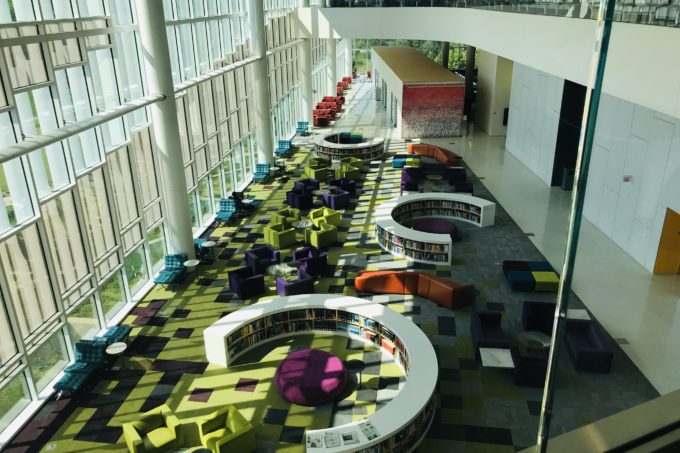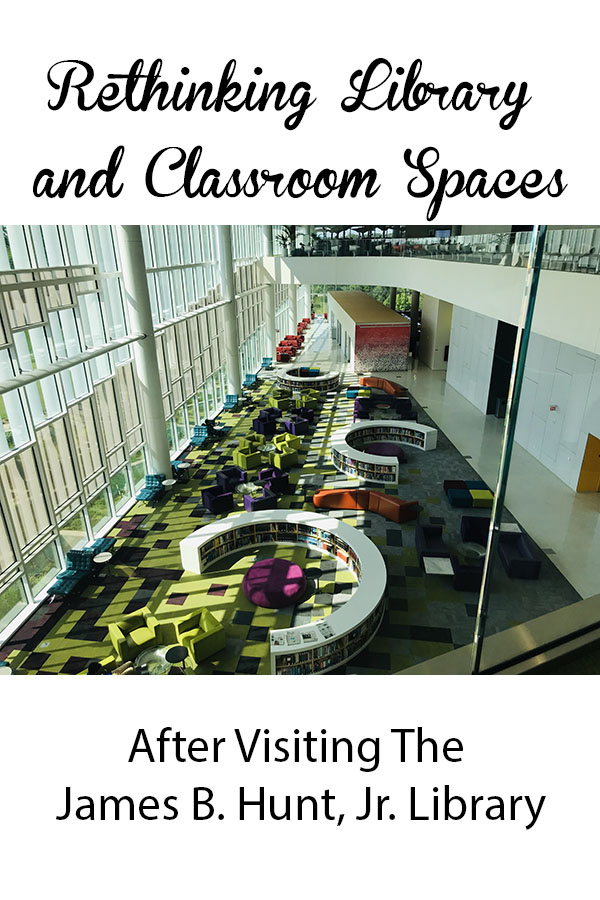
If you ever find yourself near Raleigh, North Carolina, it would definitely be worth your while to visit the James B. Hunt, Jr. Library on the campus of North Carolina State University.
This post contains some affiliate links for your convenience (which means if you make a purchase after clicking a link I will earn a small commission but it won’t cost you a penny more)!
When you enter The Hunt Library, you’ll quickly realize that this is not your typical library. Gone are the long wooden tables and hard wooden chairs that spread throughout most school libraries. Here you will find a wide array of spaces and comfortable furniture that support your needs whether that be working alone, with a partner or in small groups. Your group can even book study rooms if you need a place to talk and work.

Aside from the multiple types of spaces and furniture available for work areas, two things stood out for me. First, there were many surfaces where patrons could write. Tables were either manufactured whiteboard tables or were covered in glass to make them writeable. Study room walls were whiteboards as well. Some of the smaller semi-enclosed areas were set up the same way.

Secondly, that small group areas were set up with large monitors where group members could plug in their computers to share their screen. Both of these tools quietly created a collaborative environment.
I have to admit, I always leave here a little more inspired than when I came in. Then reality hits. I go back to my space. I don’t have funding. I have hard wooden tables and chairs. What can I do?
Re-Imagine the Space
While you may not have a tremendous amount of funding at your disposal, there are things you can do to make any space more student-friendly and hopefully drum up a little support along the way.
Ask Your Stakeholders What They Want
One of the best ways to gain support in your redesign efforts is to have data to support it. When I began to think about changing the design of our library, I put a large piece of paper and markers on the table with the question, “If you could change anything about the library, what would those changes be?” I have to tell you that I received some very interesting answers: a waterslide, McDonalds, Starbucks, etc. Three ideas kept resurfacing: new paint, more comfortable chairs, and better books. Armed with that data, I approached administration and have been able to bring their wishes to at least some degree of fruition over the years.
I would recommend using a Google Form instead of the large sheet of paper. I would share it not only with students, but with staff and possibly parent and community members depending upon how your space is used. The form would make the gathering and sharing of data much easier.

Ask Yourself the Hard Questions
-Does your classroom reflect a teaching/ learning environment that is best for you or the students?
-Do you have space for students to work alone and with a partner or group?
-Do you have students move their desks/ tables to accommodate different learning activities or are they stuck in the same style rows like the classrooms you learned in?
-Do you have a comfortable spot where students can work?
Where To Begin?
1. Create your plan – Armed with the information you have gleaned from yourself as well as others, it’s time to lay down a plan. It is hard to sell an idea if you don’t really know what you want. Write or draw it out and come up with a way to describe it to others- especially those who hold the purse strings. Be sure to back up your plan with the data you collected and even research on how students learn best.
2. Fix what you can – One of the best places to start is to begin doing those things you can do with little to no money. You can rearrange the furniture you do have to begin reshaping the learning environment. Paint and fabric can be used to spruce up your space to make it more inviting. (Be sure to check with your district policies regarding painting and requirements for fabric and furniture before making purchases.)
3. Ask for help – Check in your community to see if there are organizations that are looking for ways to help in the schools. We have had great success in getting help to build things we needed this way. Check to see if your school’s PTA or PTSO can assist with funding.
4. Ask for Donations – When I was building our Makerspace I posted on Facebook asking if anyone had things like Legos or K’nex they were looking to discard. I had a parent of a former student provide me with a huge box of both.
5. Share your vision – One of my favorite moments in the process of transforming my library came purely by chance. I had applied for a grant to fund our makerspace. One day over the summer, a person who was helping to make the decision about the grant came out to school the day of the meeting. I just happened to be at school. When she toured the library, she brought up about the grant, because she didn’t know anything about makerspaces. I get a little passionate about the library to say the least. Because I had my plan firmly engrained in my brain, I was able to “sell” the plan to her. In turn, she sold the plan at the meeting that night and we were awarded the grant.
6. Be grateful and acknowledge any assistance, no matter how small- Always…always, provide some type of public acknowledgement of the contributions of those who help you build your vision. It could be a thank you card, a thank you post on your facebook page, an email, saying thank you at a meeting or an article on the school’s website or in the newspaper. People are willing to help you if they feel sincerely appreciated.
Get Inspired
While we my not have millions at our disposal to create our dream spaces, there are small changes we can make that can have a big impact. I highly recommend visiting other schools and places like the James B. Hunt, Jr. Library. You can go in and visit the library on your own or schedule a tour if you plan to bring a group. I highly recommend scheduling a tour. Your guide will show you places and explain spaces that you would not learn about on your own.
